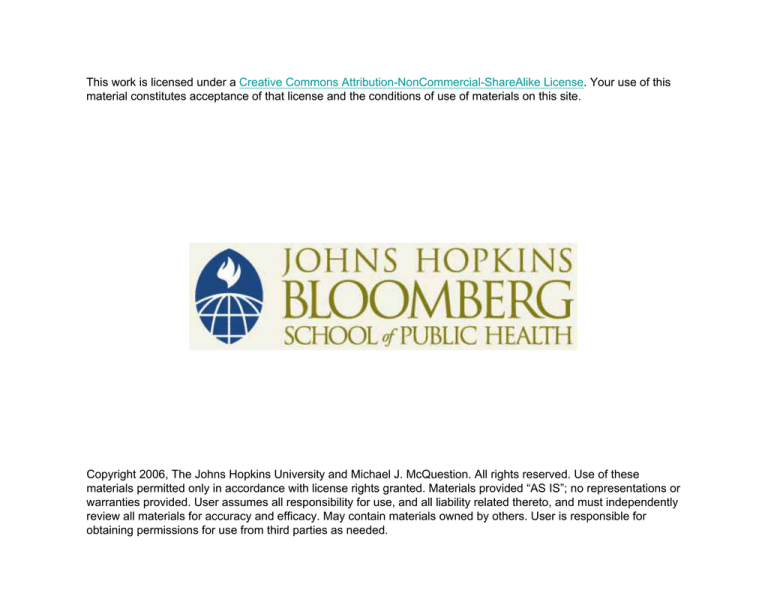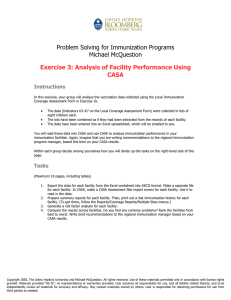
This work is licensed under a Creative Commons Attribution-NonCommercial-ShareAlike License. Your use of this
material constitutes acceptance of that license and the conditions of use of materials on this site.
Copyright 2006, The Johns Hopkins University and Michael J. McQuestion. All rights reserved. Use of these
materials permitted only in accordance with license rights granted. Materials provided “AS IS”; no representations or
warranties provided. User assumes all responsibility for use, and all liability related thereto, and must independently
review all materials for accuracy and efficacy. May contain materials owned by others. User is responsible for
obtaining permissions for use from third parties as needed.
Improving Provider Performance
Michael J. McQuestion, PhD, MPH
Johns Hopkins University
Objectives
After listening to, viewing, and studying the lecture
materials in this course, you will be able to do the
following:
− Understand the problems of inappropriate
timing and missed opportunities for vaccination
− Utilize the CASA Program to analyze
immunization provider efficiency
2
Section A
The Efficiency Problem
Problem Definition
Some children utilize health services but remain
unimmunized
Some possible reasons
− Low vaccine efficacy
− Vaccines, supplies out of stock
− Parental rejection
− Provider inefficiencies
4
Framing the Efficiency Problem
System level
− Vaccine failures are almost always due to poor
cold chain management
− Stock outages reflect weak logistical systems
− Vaccination norms and procedures may be out
of date
− Supervision may be inadequate
Continued
5
Framing the Efficiency Problem
Local level
− Health workers do not know best immunization
practices
− Health workers do not follow program norms
and procedures
− Health workers do not correctly utilize available
information
− Health workers do not educate parents
− Health workers are unmotivated
Continued
6
Framing the Efficiency Problem
System-level program inefficiencies require
system-level solutions
Most local-level problems can be framed in terms
of health worker performance
− Easier to solve
− Requires supervision and feedback
− May require retraining, reallocation of program
tasks
7
Provider Inefficiencies
Missed opportunity: a health care encounter in
which a person is eligible to receive a vaccination
but is not vaccinated completely
Inappropriately timed vaccination: a child receives
one or more vaccinations before or after the
recommended age
Note: provider inefficiencies are distinct from
immunization dropout, a health behavioral problem
we will consider in a later lecture
8
Magnitude of the Problem
A review of 70 observational surveys in 44
industrialized and developing countries found a
median 32% of eligible women and children had
experienced missed immunization opportunities
(Hutchins, Jansen and Robertson 1993)
− Industrialized: 15%
− Developing: 41%
Continued
9
Magnitude of the Problem
United States
− Population-based sample of 1,163 children in
Oregon and Washington
X 60% up to date at age 24 months (Bobo et
al 1993)
− Mail and telephone survey of 1,500 employees
of Johnson & Johnson
X 65% of children born 1984–1991 up to date
at age 24 months (Fielding et al 1994)
10
Measuring the Problem
The most common indicator of missed
opportunities in the difference between DTP1 and
DTP3, or TT1 and TT2 vaccination rates
The following slides show why these indicators are
most meaningful at the local level
11
Little Regional Variation
Reported DTP1 and DTP3
Coverage by WHO Region
A
fr
ic
a
A
E.
m
er
M
ic
ed
as
ite
rr
an
ea
n
SE
A
si
a
W
.P
ac
ifi
c
120
100
80
60
40
20
0
2000
2000
2001
2001
DTP1
DTP3
DTP1
DTP3
12
More Variation at National Level
Reported DPT1 and DPT3 Coverage,
Selected EMRO Countries
2000 DPT1
2000 DPT3
2001 DPT1
2001 DPT3
Af
gh
an
is
ta
Ba n
hr
ai
n
D
jib
ou
ti
Eg
yp
t
I
Pa raq
ki
st
a
So n
m
al
i
Su a
da
n
120
100
80
60
40
20
0
13
And Even More at the Local Level
Percent of women ages 15-49 receiving TT1 and
TT2 vaccinations in routine EPI, by health area,
Region Sud-Est, Haiti, 2000-1
TT1
T
hi
ot
te
B
el
le
A
G
ns
ra
e
nd
G
os
A
ie
ns
r
e
a
P
itr
es
TT2
B
ai
C
ne
ot
es
t
de
F
er
Ja
C
cm
ay
el
es
-J
ac
m
el
M
ar
ig
ot
La
V
al
le
e
0.5
0.45
0.4
0.35
0.3
0.25
0.2
0.15
0.1
0.05
0
14
Causes of Missed Opportunities
Cause
Failure to administer vaccines
simultaneously
False contraindications
Negative health worker attitudes
Logistical problems
Parental refusal
T Notes Available
Percent of all Missed
Opportunities
22
19
16
10
3
15
Missed Opportunities in the U.S.
Reason
Impact
Fixability
Provider unaware patient is eligible
+++
+++
Provider policy not to vaccinate
+++
+++
Failure to provide simultaneous vaccinations
+
++
Inappropriate contraindications
++
+
Administrative barriers, cost
+
+++
T Notes Available
16
An Empirical Example
Cutts et al (1991) studied immunization program
efficiency in Guinea Conakry and four cities in
Mozambique
Methods: WHO EPI 30-cluster household surveys,
clinic visits
Results: among children with cards, inefficiencies
reduced coverage by 29% in Conakry and 19% in
Mozambique
17
DPT Rates
100
80
60
40
20
0
1985 DPT1
1985 DPT3
1987 DTP1
ne
m
ba
In
ha
Q
ue
l
im
an
e
Te
te
ira
1987 DTP3
Be
percent vaccinated
DPT Coverage Rates from Eight EPI
Cluster Surveys in Four Mozambican
Cities (Cutts et al 1991)
18
Missed Opportunities
Cumulative inefficiency effects, children 1223m with cards, Mozambique 1987
average
7 surveys range
fully, correctly vaccinated
added coverage with:
correct timing
simultaneous vaccination
vaccinate at growth monitoring
full efficiency
62
51-74
11
2
6
81
6-15
1-4
3-8
70-96
19
Pushed up in ‘87
p ercen t vaccin ated
DPT Coverage Rates from Five EPI
Cluster Surveys, Guinee Conakry
(Cutts et al 1991)
100
80
60
DPT1
DPT3
40
20
0
1983
1985
1986
1987
1989
20
What Could Have Happened
Program Inefficiency Effects on Potential
Vaccine Coverage, Conakry 1989 (Cutts et al
1991)
100
90
80
70
60
DTP1
50
DTP3
40
fully im m unized
30
20
10
0
baseline: vaccinated
correctly
potential coverage
21
Side by Side
Percent of Children with Cards and Fully
Immunized, Conakry and Mozambique (Cutts
et al 1991)
90
80
70
percent
60
cardholders
50
full efficiency
40
actual
30
20
10
0
Conakry
Mozambique
22
Summary
Eliminating timing errors and missed opportunities
would significantly impact immunization coverage
rates
However, as Cutts et al (1991) demonstrated, high
dropout rates may still depress coverage
23
Section B
Improving Provider Efficiency
Improving Provider Efficiency
25
Strategies for Reducing Missed Opportunities
Establish clear guidelines, standards for
immunization
Educate providers
Provide feedback about missed opportunities and
immunization rates
Modify office practices to change standards of care
Provide incentives
T Notes Available
26
Supervision
A good supervisor
− Focuses on performance problems
− Does not threaten or confront but constructively
criticizes
− Uses established assessment criteria
− Provides positive feedback, incentives public
recognition for a job well done
− Maintains confidentiality
In recent years, new approaches to supervising
health workers have emerged
Here are two:
− Peer training/supervision
− CDC’s AFIX system
27
An Example of Peer Supervision
Robinson et al (2001) studied a peer training
intervention in Maluku Province, Indonesia, in
1993–1994
Theory: peer trainers are a non-threatening
supplement to hierarchical classroom training
Intervention: immunization nurses spent
1–2 weeks with peers at 15 low-performing health
centers
Continued
28
An Example of Peer Supervision
Methods
− Non-randomized case control study
− Retrospective and prospective administrative
data for each health center
− WHO cluster sample surveys
− Supervisory visits before and after
− Trainers’ assessments
29
Adjusted Coverage
percent
Adjusted coverage by antigen before and after
training, Maluku Indonesia (Robinson et al 2001)
80
70
60
50
40
30
20
10
0
before
after
DPT1
OPV3 measles
training
DPT1
OPV3 measles
no training
30
Results: Performance
30% improvement in key immunization practice
scores, especially:
− Daily refrigerator temperature control
− Record-keeping, on-time reporting
− Vaccinating mildly ill children
High acceptability among hosts, trainers
Cost: U.S.$53 per trainee, U.S.$0.05 per dose
31
AFIX
Over the period 1988-–94 the state of Georgia
developed the AFIX system:
− Assessment of center performance
− Feedback of assessment results
− Incentives to improve performance
− eXchange of performance data among centers
T Notes Available
32
The Georgia Experience
Adjusted effects of three clinical
practices on the log-odds (95% C.I.) of
a child's vaccinations being up-todate, 227 GA public health clinics
log-odds
2.5
2
1.5
1
0.5
0
telephone
reminder
T Notes Available
lead nurse
incentive
charge fee
Continued
33
The Georgia Experience
Theory
− Assessment with feedback creates awareness
necessary for behavioral change
− Incentives and public recognition are powerful
motivators of behavioral change
− Awareness of how others are doing (reflexivity)
motivates improvement
34
Assessment
Standardized routine collection, analysis and
summary of immunization records
Purpose
− Diagnose delivery problems
− Identify useful changes in policy and practice
− Monitor, refine interventions
35
Feedback
Return of diagnostic information to front-line staff
and decision makers
Purpose
− Monitor progress toward goals
− Motivate to improve
− Develop local solutions
36
Incentives
Provide extrinsic motivation to improve
performance
Purpose
− Recognize accomplishments
− Enhance pride in workmanship
− Reinforce sense of organizational mission
37
eXchange of information
Comparison to peers
Purpose
− Compare process and outcome indicators
− Exchange ideas among peers
− Provide mutual support
− Stimulate friendly competition
38
AFIX
Types of problems identified
− Late starts
− Non-adherence to recommended schedule
− Children falling behind schedule
− Children dropping out of system
− Ineffective reminder/recall strategies
− Failure to give vaccines simultaneously
− Inadequate record-keeping
Continued
39
AFIX
To identify clinic-specific problems
− Compare each variable across sites
− Compare each variable temporally
− Compare variables within each site
Results are presented
− At exit interviews with local staff
− In conferences with decision-makers
− At workshops with providers
− As a challenge
− To encourage creativity
Continued
40
AFIX
LeBaron et al (1999) documented the introduction
of AFIX in four states and two cities
In 1994, clinic-based coverage (4:3:1, ages 19–
35m) was lower than population-based coverage
(determined by National Immunization Survey)
During 1994–96 clinic-based coverage rose an
average of 11% per year
− A rate faster than population-based coverage
increases in 5/6 sites
Continued
41
AFIX
Most of the initial increases were due to improved
clinic record-keeping
Net of this documentation artifact, average annual
improvement rate was 5%
Average cost per site: U.S.$49, 533/yr
(U.S.$2/child)
Recommendation: generalize AFIX nationwide
42
Section C
CASA
AFIX Tool: CASA
Main assessment tool: CASA
Methods
− Enter a random sample of individual
vaccination records from clinic or an
immunization register
− Analyze age-appropriateness, missed
opportunities for different antigen combinations,
demographic sub-groups
− Prepare specific reports
Examples
− Up-to-date status by age group, antigen
− Lists of incompletely immunized children
− Frequency, types of missed opportunities
44
− Quality of documentation
AFIX Tool: CASA
Provide feedback on
− Key findings: coverage, practices
− Strengths of the site
− Areas for improvement
X Documentation
X Missed opportunities
X Reminders, recalls
X Parent, provider education
X Vaccine handling, techniques
Brainstorm local solutions
45
VFC Update
46
CASA Methods
Create incentives for improvement
− Examples
X Identify local resources to tap
X Leave free materials, upgrades
X Offer training
X Invite to present at conferences
X Certificates, letters of commendation
X Document, disseminate case studies
47
CASA Methods
Exchange experiences, best practices via
− Lists of centers ranked by specific performance
indicators
− Documented evidence-based strategies
− Conference presentations
− Peer exchanges, mentoring
48
Summary
Vaccine provider inefficiencies, like other
performance problems, are usually remedied by
good supervision and feedback
49




